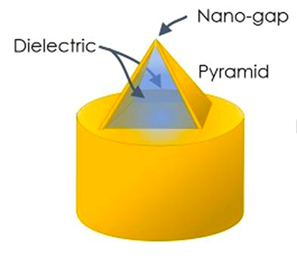

High Temperature Optical Fiber Devices
University of Pittsburgh and Carnegie Mellon University researchers have developed an optical fiber-based sensor device suitable for use above 500 °C. Developed using nanofabrication and thin film deposition techniques this novel sensor can be used as a near-infrared (near-IR) or IR probe capable of plasmon to photon coupling. Not only could these high temperature devices be used in sensing but may also be used for thermal energy extraction with applications in harsh environments and high temperature locations (e.g., during combustion processes) previously inaccessible with existing sensor technology.

Description
Optical waveguides and optical fiber-based sensor technologies are increasing being investigated for use in extreme environments (e.g., low temperatures and remote locations) as passive monitors of processes or stability of key infrastructure. Near-field probes are optical sensors commonly used to monitor environmental parameters including temperature or chemistry. Current there is a lack of near-field technology suitable for high temperature settings. This technology, developed using inorganic material with inherent high temperature stability and gold (Au), can be stable in temperatures over 500C. Successful development of these probes may revolutionize the field of passive extreme high temperature monitoring.Applications
• Combustion processes monitoring• Temperature sensing in solid oxide fuel cells
• Chemical sensing
Advantages
Current strategies to measure spectral near-field thermal responses use either a sharp tungsten tip or a platinum-coated atomic force microscopy tip to scatter light to produce a signal. However, this approach has low accuracy due to a poor signal-to-noise ratio. Gold nanosphere and nanorod (GNR) tips can undergo localized surface plasmon resonance (LSPR) in the presence of near-IR light but were previously deemed unsuitable for use at high temperatures due to agglomeration. However, when fabricated with an anodic aluminum oxide (AAO) layer, GNRs are stable at high temperatures and produce thermoplasmonic emissions that can be propagated through optical fibers and directly observed.Invention Readiness
Novel probes were fabricated with a GNR-AAO layer on a sapphire fiber. The probe was campanile in shape with two of the four surfaces coated with GNRs and a narrow gap at the tip. LSPR modes were observed directly at 1100 K (827C) confirming the ability of these probes to function at high temperatures. Further development, including the use of platinum instead of gold and modification of the gap at the tip of the campanile probe, may lead to stability at even higher temperatures.IP Status
https://patents.google.com/patent/US20240302207A1Related Publication(s)
Li, J., Wuenschell, J., Li, Z., Bera, S., Liu, K., Tang, R., Du, H., Ohodnicki, P. R., & Shen, S. (2021). Fiber Coupled Near‐Field Thermoplasmonic Emission from Gold Nanorods at 1100 K. Small, 17(17). https://doi.org/10.1002/smll.202007274
Li, J., Wuenschell, J., Jee, Y., Ohodnicki, P. R., & Shen, S. (2019). Spectral near-field thermal emission extraction by optical waveguides. Physical Review B, 99(23). https://doi.org/10.1103/physrevb.99.235414